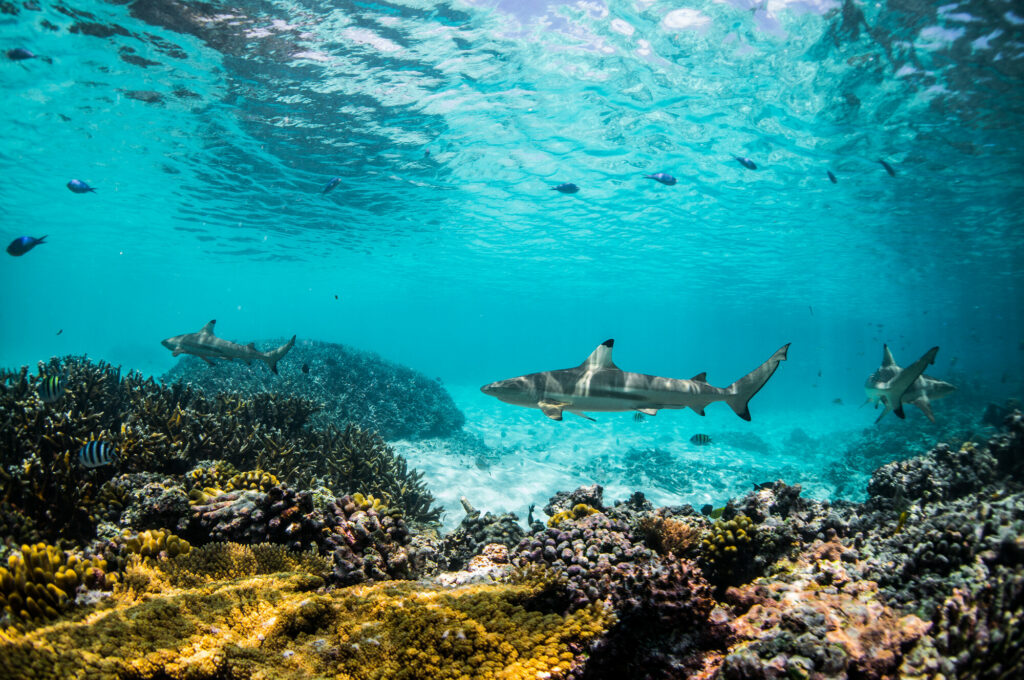Celebrating 10 years of D’Arros Research Centre
What might wilderness mean? We reflect on a decade of the Save Our Seas Foundation at the D’Arros Research Centre
‘I think that many of the people who seem uninterested in the marine environment, on other Seychelles islands like Mahé or Praslin, are simply so because they’ve not yet experienced pristine wilderness like this,’ says Ellie Moulinie, a research officer at the Save Our Seas Foundation D’Arros Research Centre (SOSF-DRC).
And what a wilderness it is. D’Arros Island and St Joseph Atoll lie at the outermost reaches of Seychelles’ relatively uninhabited Outer Islands. The ocean here is a haven for a bewildering array of life and the islands are home to some of the largest nesting grounds for Endangered green and Critically Endangered hawksbill turtles in the world. Reef manta rays swoop and swirl along the coral reefs to socialise at their cleaning stations in the densest aggregation in Seychelles. One of the largest nesting populations of fouqet (wedge-tailed shearwater) in the Western Indian Ocean resides here, shuffling into their burrows at night after trips of up to 750 kilometres (460 miles) to forage along the south-western edge of the Amirantes Bank. And the shark life has long prompted much of the busy-ness of the SOSF-DRC, with researchers tracking the nomadic exploits of bull and tiger sharks and keeping tabs on shark pup nurseries for the likes of sicklefin lemon and blacktip reef sharks. Here, where the heavy hand of human activity has not yet fallen, the SOSF-DRC has found traction to explore and conserve tropical island biodiversity.
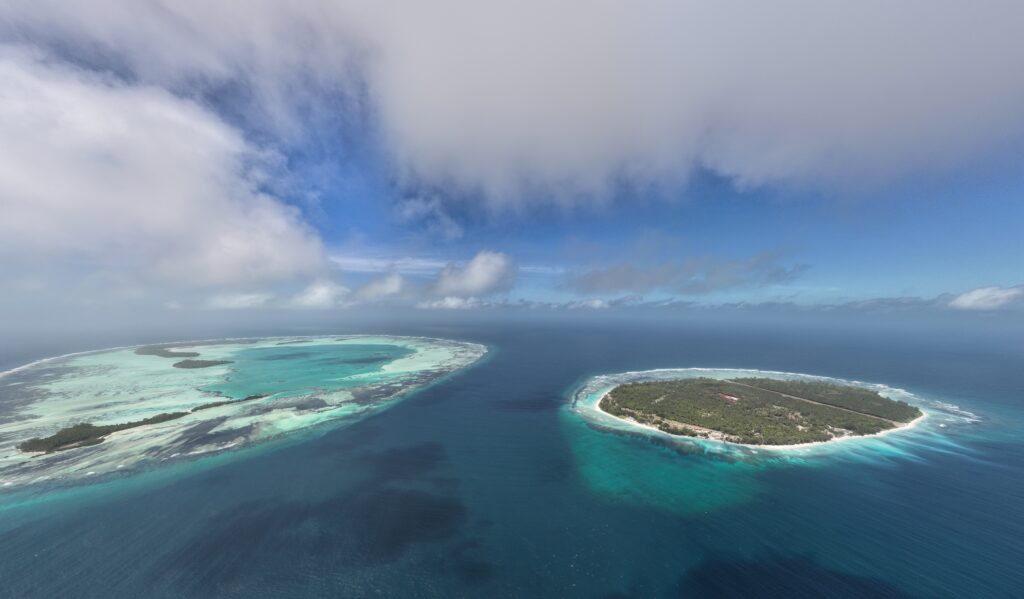
Aerial view of St Joseph atoll (left) and D'Arros Island (right) from the north. Photo by Sebastian Staines | © Save Our Seas Foundation
But the very remoteness that makes D’Arros Island and St Joseph Atoll magical, and has kept them in near-pristine condition, is only one side of this conservation coin. Certainly, the relatively intact nature of the ecosystems around the SOSF-DRC have made it the hub of a prime natural laboratory. As Dr Robert Bullock, the centre’s research director puts it, ‘Much of the research at the SOSF-DRC has focused on understanding just how important places like this are for marine and land animals (for breeding and feeding and as nurseries and safe havens). We can use what we find here as a template for understanding similar places around Seychelles and the world.’
This August, the Save Our Seas Foundation (SOSF) celebrated its role on the island as custodian of the SOSF-DRC for a decade. In the same month, the SOSF-DRC ran its D’Arros Experience for young learners selected from around Seychelles. Its purpose is to give access to curious minds, affording learners hands-on experience of science, conservation and the natural history of the island. The premise is that anyone who experiences the magic of a place like D’Arros is inspired to make a change. Ellie’s colleague and fellow research officer on the island, Dillys Pouponeau, agrees. ‘I grew up going on hikes and doing activities outdoors, but the sense of responsibility for our environment didn’t really hit me until I saw an island like this or Aldabra.’
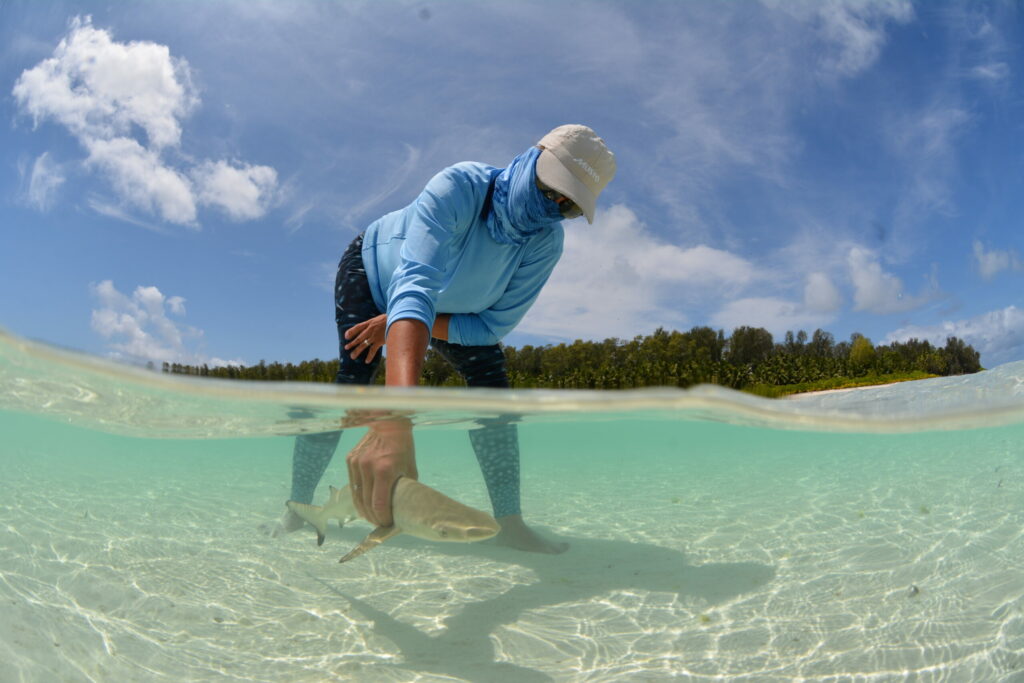
A juvenile blacktip reef sharks about to be released after its work-up. Photo by Robert Bullock | © Save Our Seas Foundation
The opportunity to see the world as it once was – indeed, how the world might be again if we take responsible steps – is a rare one, in particular for young Seychellois citizens whose entire nation is closely linked to the ocean. For Ellie and Dillys, a celebration of the SOSF-DRC’s decade in action is therefore also a moment to pause and reflect on where the centre is heading – and what role it may come to play in nurturing the conservationists and scientists who will lead Seychelles into its blue future.
When the D’Arros Research Centre was started in 2004 it was under private ownership. However, the SOSF assumed management in 2012 and the following decade has seen a succession of projects. From these we have learnt, for instance, that St Joseph Atoll is an important nursery for sicklefin lemon and blacktip reef shark pups, where Dr Ornella Weideli showed that most of these sharks were caught in a mark-recapture study not even 500 metres (547 yards) from where they were first tagged. Dr Lauren Peel’s research into reef manta rays revealed that they are highly resident in Seychelles and that D’Arros and St Joseph in particular are key habitats for these animals. And Dr Chantel Elston delved into the secret lives of stingrays by tagging and tracking 90 mangrove whiptail, cowtail and porcupine rays in St Joseph’s lagoon and gave us insight into how animals in the middle of the food chain use the islands and what role they play in the ecosystem.
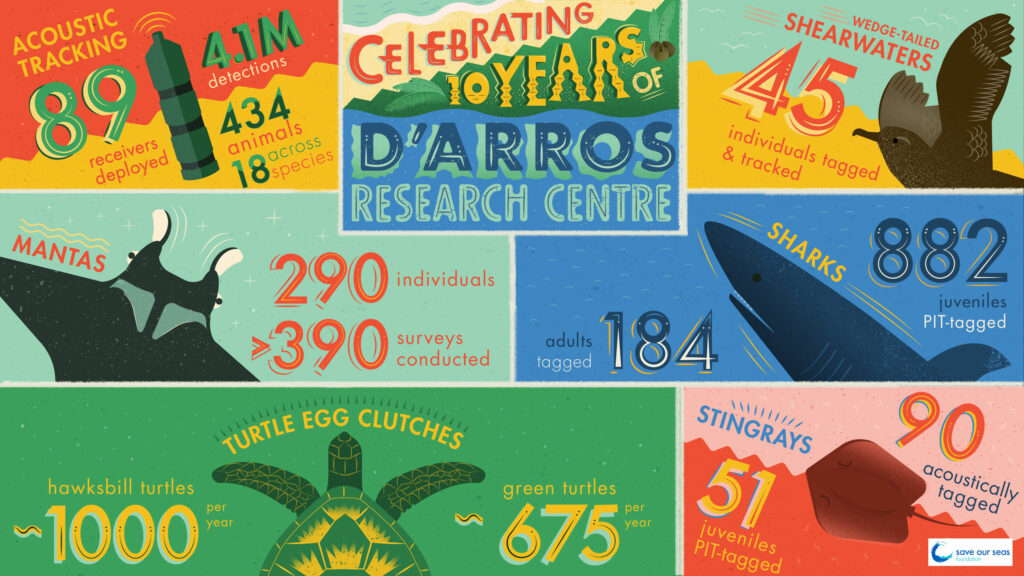
10 year anniversary infographic showcasing some of the research achievements to date. Artwork by Jamy Silver | © Save Our Seas Foundation
There has always been a conservation imperative to the research undertaken here: of the seven shark species that have been studied so far, two are Endangered, four are Vulnerable and one is Near Threatened, according to the criteria of the International Union for the Conservation of Nature (IUCN) Red List of Threatened Species. A network of 89 acoustic receivers have peppered the sea floor across this region (77 are currently active) and they act as ‘listening stations’ tethered in place to detect the unique ‘ping’ of an acoustic tag implanted in an animal as it swims past. In this way, the researchers have kept tabs on the movement patterns of 184 individual blacktip reef, sicklefin lemon, grey reef, tawny nurse, silvertip, bull and tiger sharks that have been tagged in the past decade.
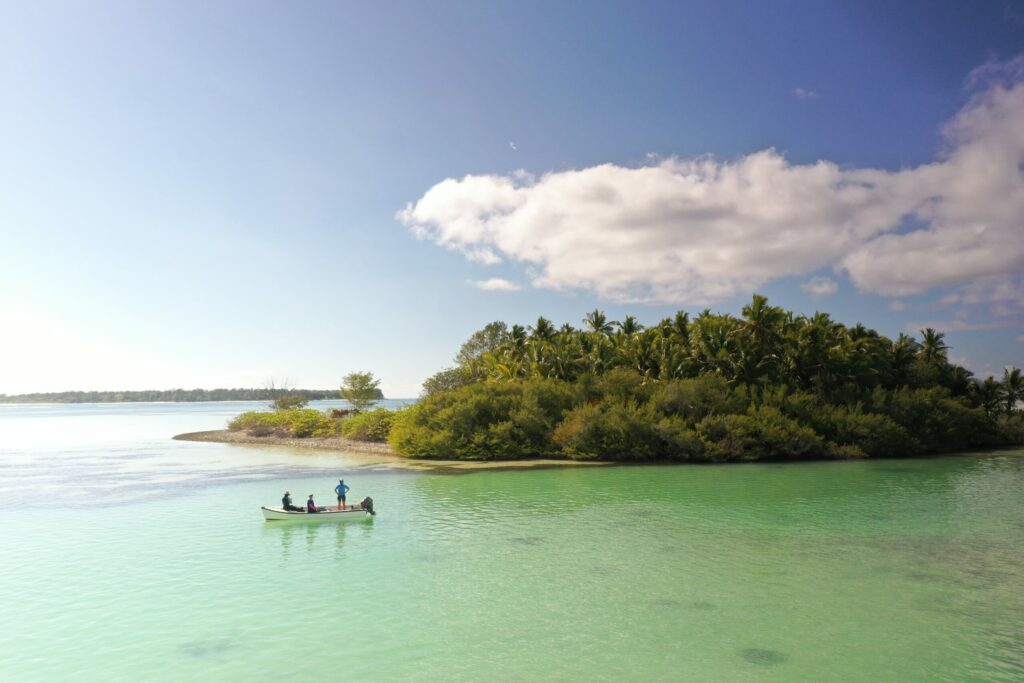
The SOSF-DRC team in the atoll, near Ressource Island. Photo by Dillys Pouponeau | © Save Our Seas Foundation
Ten years have also seen various shifts in the leadership at the SOSF-DRC, each era bringing personalities who have their individual affinity with wilderness and what it means to be its custodians. The current programme and research directors, Henriette Grimmel and Dr Robert Bullock, respectively, began their tenure at the SOSF-DRC at a tumultuous time in recent world history. ‘We started working remotely in July 2020. For six months, the Covid-19 regulations meant we spent our time trying to prepare ourselves for on-island work using materials we could use behind a computer!’ explains Henriette. The pause brought about by Covid-19 also prompted a degree of reflection for Henriette, Robert and the team. ‘What is worth continuing?’ they pondered. ‘What is worth doing new?’
Henriette hails from Switzerland, but her interest in marine conservation means that D’Arros is only the latest in her transoceanic migrations. Aside from her day-to-day work keeping life on the island organised, her particular interest lies in marine spatial planning: how can we carve the oceans into manageable units that balance protection and development? At D’Arros, that means drawing on the foundation of knowledge laid by this decade of research projects to devise the best means to manage a near-pristine wilderness – a philosophical privilege not afforded to many marine planners, since most of their work occurs in more densely populated or more heavily exploited regions.
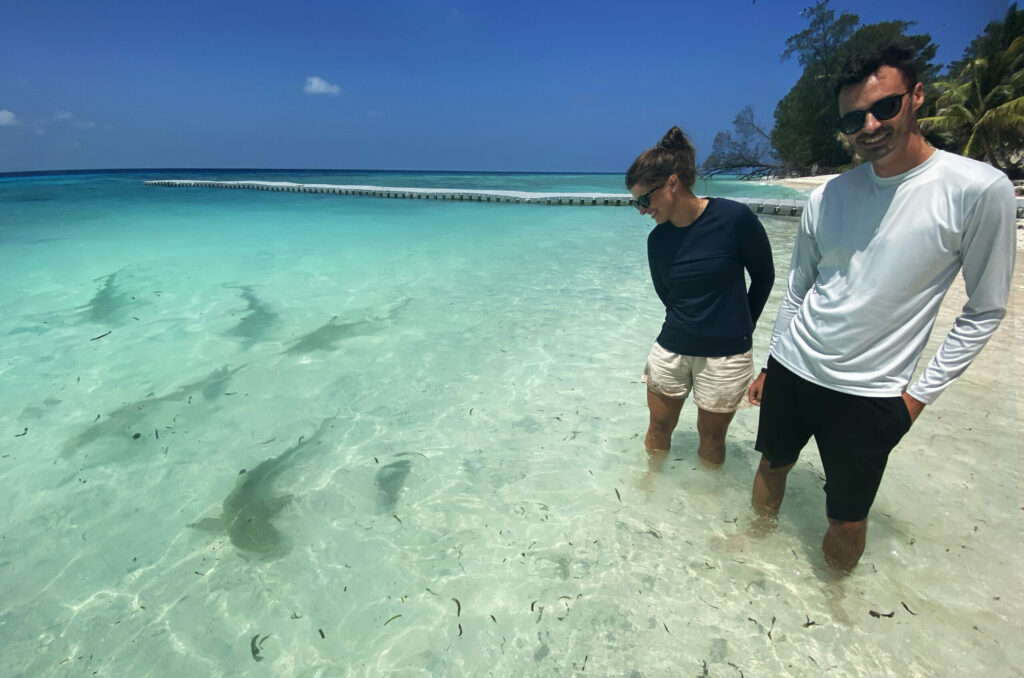
Program Director Henriette Grimmel (left) and Research Director Rob Bullock (right) with blacktip reef sharks at D'Arros. Photo by Luke Saddler | © Save Our Seas Foundation
‘It sounds cheesy, which is why I cringe to say it, but it’s true! My love for the ocean stems from a childhood spent watching David Attenborough’s documentaries,’ admits Robert by way of first introduction. Having completed his PhD at the Bimini Biological Field Station Foundation (BBFSF) in The Bahamas and subsequently worked for the IUCN, Robert is a long way now from childhood listening to the narration of the world’s favourite television natural historian. But his point still speaks to the idea Ellie and Dillys first raised: how do we fall in love with wilderness? And more importantly, how do we learn to care for it if we don’t have direct access to it? For Robert, travel-by-armchair was enough to transport his childhood curiosity to the submarine realm – and launch a life spent getting to know the world’s wildest places and protecting their creatures.
As the staff member in charge of advancing the research agenda at the SOSF-DRC, Robert now draws on the past to inform the future. ‘We sit with this incredible foundation of understanding at the SOSF-DRC. But moving forward, the research questions we ask have to give us answers that improve species conservation,’ he explains.
If the Covid-19 pandemic highlighted anything to us all, it’s that for the most part our relationship with nature is fundamentally broken. At some point as we try to repair it, we may find our way back to a more inclusive understanding of sustainability. But in the interim, the responsibility remains with the researchers under Robert’s direction to use their work to mitigate the worst of the challenges and re-imagine wilderness in our rapidly changing world.
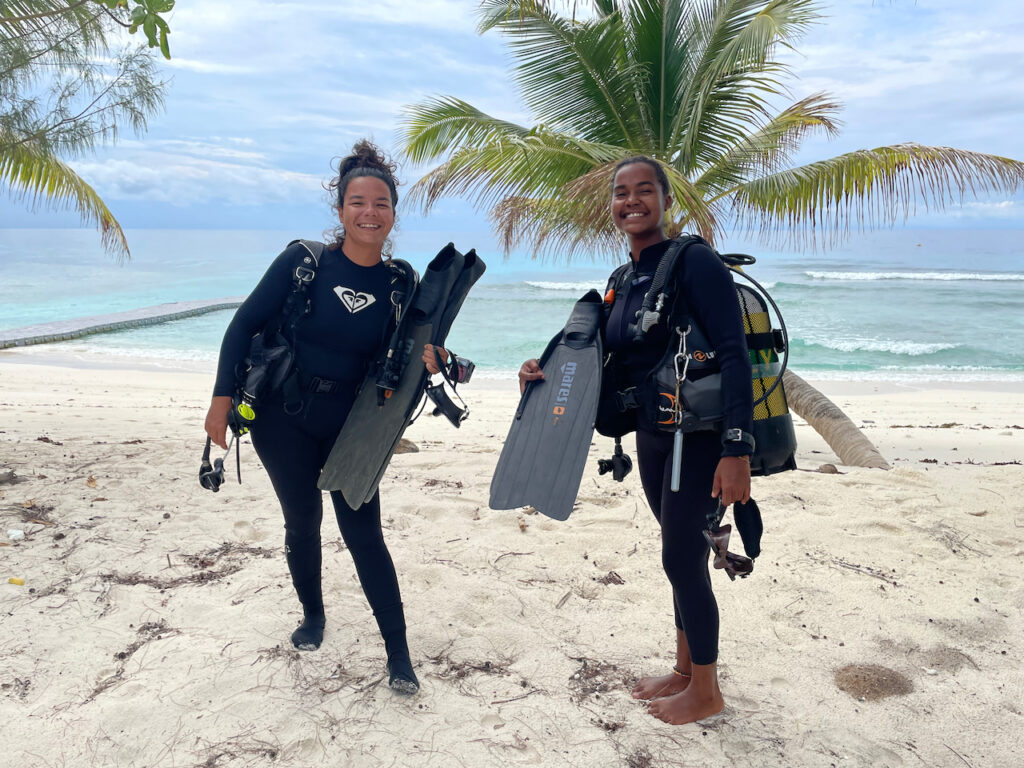
Ellie Moulinie (left) and Dillys Pouponeau (right) ready to shore dive to the cleaning station. Photo by Henriette Grimmel | © Save Our Seas Foundation
‘The SOSF-DRC has always been a research centre and ultimately it will always remain a research centre. But I think now we are heading along a path to decipher how to make sure the research translates into action,’ says Henriette. ‘The world is complex. It’s not a given that the best available science is taken up into policy and enacted. But I think that here in Seychelles at least, much work is being done to ensure that the information we gather is shared and that the public can more easily learn about what we find.’ She turns to nod in the direction of Ellie and Dillys. ‘These women are learning alongside us on this island, are being steeped in research experience and are seeing this wilderness at first hand. It is they, I believe, who will lead us into better ways of balancing science with conservation and policy.’
Ellie nods quietly. ‘As a young Seychellois who was able to get this job in this place, I count myself extremely lucky. Young people of my country in the environmental field don’t usually get the exposure to research and work that this one offers. A position like this gives them an opportunity to move forward in conservation employment.’ She pauses a moment before continuing, her voice stronger. ‘I’m actually working in the field doing the science, doing the research and field work. Not many NGOs in Seychelles do that. I love my job! I love my SOSF-DRC family, I love the sharks, I love the work we’re doing here. And I’m very passionate about it!’
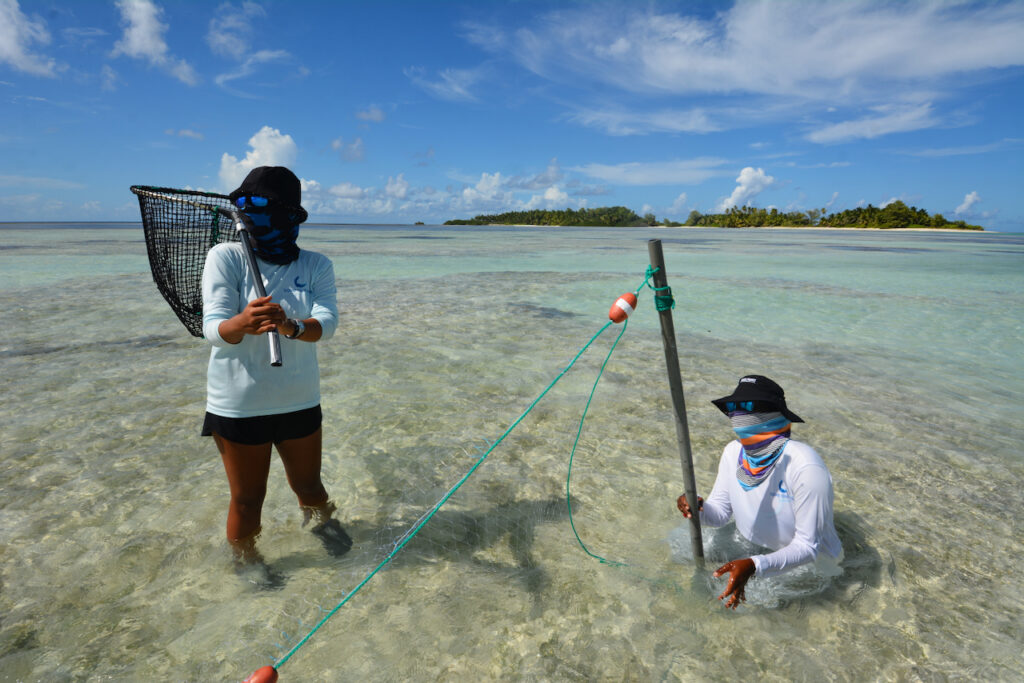
Research Officers Dillys and Ellie in the atoll - waiting for juvenile sharks to be caught by the gill net. Photo by Henriette Grimmel | © Save Our Seas Foundation
The SOSF-DRC team is at the cusp of a new decade, with a solid basis of research upon which to draw. The centre’s projects will continue to help us understand the biodiversity of this bluest of gems in Seychelles’ ocean crown. ‘People who are interested in nature don’t necessarily have access to it,’ continues Dillys. ‘But they want to learn. That’s why I think the education part of conservation is so important.’ As the SOSF-DRC’s first Seychellois research officers, Ellie and Dillys are stepping across the divide that typically causes young scientists to struggle; they’re bridging the gap between their university qualifications and the experience they need to guide the policy decisions of the future.
– Dillys Pouponeau
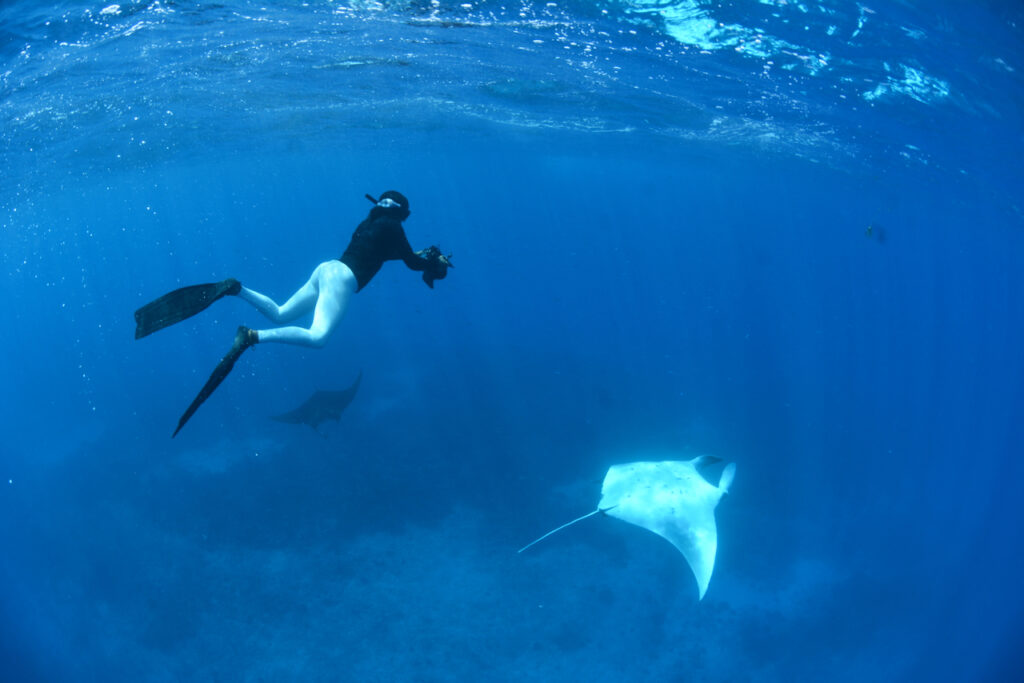
Research Officer Dillys Pouponeau interacting with reef manta "Banshee" during a Manta Survey this year. Photo by Henriette Grimmel | @ Save Our Seas Foundation
‘I found a job in conservation science that allows me to think of solutions and fix some of the damage we’ve done, to come up with ways to prevent further degradation. But I only took on this work because I understood what it means: to me and to my future,’ concludes Dillys.
Both Dillys and Ellie become highly animated as they discuss the children’s camps, communicating research results, and their own growing basis of experience. Certainly, if the SOSF-DRC acts as the place where such passionate conservation leaders of the future meet the island’s magical diversity, the next decade will prove to be one rich in solutions.

